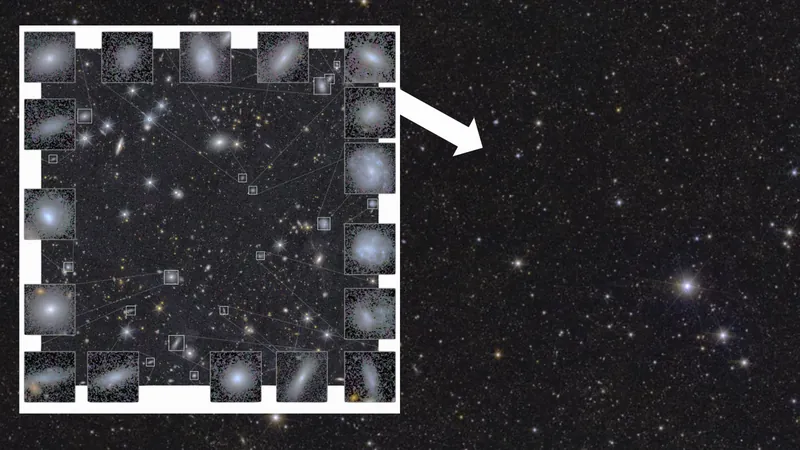
Incredible Discoveries: Euclid Space Telescope Uncovers 2,674 New Dwarf Galaxies!
2025-03-24
Author: Sarah
The groundbreaking findings from the Euclid Space Telescope are reshaping our understanding of the cosmos! Recently, a team of astronomers, led by researchers from the University of Innsbruck, conducted an extensive analysis of 25 images captured by the European Space Agency's (ESA) state-of-the-art satellite. They unearthed an astonishing 2,674 new dwarf galaxies, proving that sometimes the smallest discoveries can have the most profound implications.
Dubbed the “dark universe detective,” the Euclid Space Telescope is on a mission to unravel the mysteries of dark matter and dark energy while simultaneously constructing the most detailed 3D map of the universe to date. "We took advantage of the unprecedented depth, spatial resolution, and field of view of the Euclid data," said team leader Francine Marleau. This major stride in observation highlights Euclid’s unparalleled ability to detect and characterize dwarf galaxies, thereby offering a comprehensive glimpse into galaxy formation and evolution across diverse scales and environments.
What Are Dwarf Galaxies?
Dwarf galaxies may be small, but they play a monumental role in the universe. These little galaxies contain only a few billion stars, in stark contrast to their larger counterparts, which house hundreds of billions. Often found in orbit around larger galaxies, the Milky Way itself has several notable dwarf galaxy satellites, such as the Large Magellanic Cloud and the Small Magellanic Cloud.
Scientific theory posits that dwarf galaxies are not only remnants from the early evolution of larger galaxies, but they also form during cosmic collisions. Such interactions expel streams of gas, dust, and dark matter into space, where these smaller galaxies can emerge.
Dwarf galaxies exhibit a range of shapes: - **Spheroid Dwarf Galaxies**: Round and smooth. - **Spiral Dwarf Galaxies**: Similar structure to larger spiral galaxies. - **Elliptical Dwarf Galaxies**: More elongated and less structured. - **Irregular Dwarf Galaxies**: Chaotic architectures with a low content of heavier elements, reminiscent of early universes.
Understanding dwarf galaxies is critical to revealing the past and future of our universe, but their faintness and low stellar content make them challenging targets for observation.
Noteworthy Findings
The recent haul of 2,674 dwarf galaxies isn’t merely about numbers; it’s a gateway to deeper insight. The research team not only identified these dwarfs but also characterized them—determining their distances, stellar masses, and the environments they inhabit.
Among the discoveries: - **58%** are elliptical dwarf galaxies, known for their smooth appearance. - **42%** are irregular dwarf galaxies, featuring diverse structures. - A mere **1%** are rich in globular clusters, essential formations that often house some of the oldest stars in the galaxy. - Approximately **4%** contained a galactic nucleus, indicating the presence of a dense central hub, often a black hole. - Nearly **7%** were identified as Blue Compact Dwarfs, which are actively forming stars and are marked by their striking blue color due to hot, young stars.
With the Euclid satellite having launched in July 2023, the excitement does not stop here! Marleau and her dedicated team plan to continue their quest, employing Euclid to discover and catalogue even more dwarf galaxies, further enriching our cosmic knowledge.
The implications of such discoveries could revolutionize our understanding of the universe's structure and the formative processes of galaxies. Stay tuned for more astronomical revelations as the Euclid Space Telescope continues its pioneering mission!




 Brasil (PT)
Brasil (PT)
 Canada (EN)
Canada (EN)
 Chile (ES)
Chile (ES)
 Česko (CS)
Česko (CS)
 대한민국 (KO)
대한민국 (KO)
 España (ES)
España (ES)
 France (FR)
France (FR)
 Hong Kong (EN)
Hong Kong (EN)
 Italia (IT)
Italia (IT)
 日本 (JA)
日本 (JA)
 Magyarország (HU)
Magyarország (HU)
 Norge (NO)
Norge (NO)
 Polska (PL)
Polska (PL)
 Schweiz (DE)
Schweiz (DE)
 Singapore (EN)
Singapore (EN)
 Sverige (SV)
Sverige (SV)
 Suomi (FI)
Suomi (FI)
 Türkiye (TR)
Türkiye (TR)
 الإمارات العربية المتحدة (AR)
الإمارات العربية المتحدة (AR)